Evaluation of La-Doped Mesoporous Bioactive Glass as Adsorbent and Photocatalyst for Removal of Methylene Blue from Aqueous Solution
Abstract
A series of La-doped mesoporous bioactive glass (BG-La) materials with excellent biosafety and hypotoxicity have been prepared and tested as adsorbent. The study was aimed to evaluate the possibility of utilizing BG-La for the adsorptive removal of methylene blue (MB) from aqueous solution and test the adsorption and desorption behavior of this new material. The process parameters affecting adsorption behaviors such as pH, contact time, and initial concentration and the photocatalytic degradation of MB were systematically investigated. The result showed that BG-La had excellent removal rate (R) of MB, and BG-La showed better photocatalytic effect than undoped mesoporous bioactive glass (BG). Furthermore, the MB loaded BG-La was easily desorbed with acid solution due to its electronegativity and mesoporous structure. The result indicated that these materials can be employed as candidates for removal of dye pollutant owing to their high removal rate, excellent photocatalytic effect, desorption performance, and their reusability.
1. Introduction
Environmental pollution is mainly due to the improper waste management of industrial production process and no environmental protection consciousness of wanton development, and it is one of the concerns for the sustainable development of the earth. In particular, organic pollutants [1] that include dyes [2, 3] and agricultural wastes [4] are released into the environment and can be transported over long distances in the atmosphere, water, and land. Therefore, in order to purify water, many technology have been developing and developed, such as membrane filtration technology [5], coagulation and flocculation technology [6], electrochemical oxidation technology [7], adsorption technology [8–10], biological treatment technology [6, 11], and advanced oxidation process (AOP) [12]. However, some of the techniques shown in the effect are not ideal in practice. But because of easy operation and high cost-effectiveness, adsorption technology is considered to have good industrial application prospect of water treatment technology. Mesoporous materials, as a new adsorbent, caused wide public concern by their large specific surface area, high porosity, and so on. And mesoporous bioactive glass besides having the characteristics of traditional mesoporous materials also has high biological activity, so many researchers focus on the mesoporous bioactive glass [13]. Lanthanum has the good physical properties such as photoelectromagnetic; it can form new materials of different performance by mixing it with other materials to greatly improve their quality and performance.
But La-doped mesoporous bioactive glass materials have seldom been reported so far. In this work, La-doped mesoporous bioglass was prepared by using sol-gel method to remove methylene blue in aqueous solution, and the effect of different initial conditions on the removal efficiency was investigated. The photocatalytic activities and reusability of BG-La have also been examined.
2. Materials and Methods
2.1. Reagents and Solutions
Ethyl orthosilicate (TEOS), lanthanum nitrate (La(NO3)3·6H2O), anhydrous ethanol, triethyl phosphate (TEP), and calcium nitrate (Ca(NO3)2·4H2O) were purchased from Tianjin Kermel Chemical Reagent Co., Ltd. Polyoxyethylene-polyoxypropylene-polyoxyethylene three block polymer (P123) was purchased from Aldrich. Concentrated hydrochloric acid was purchased from Tianjin Wind Ship Chemical Regent Co., Ltd. Methylene blue was purchased from Tianjin New Fine Chemical Industry Development Center. The above reagents are analytically pure.
2.2. Synthesis of BG-La
A series of BG-La (SiO2–CaO–P2O5–La) solutions with five different chemical compositions were prepared following a previously reported method [14]. Briefly, 4.0 g of P123 were dissolved in 50 mL of ethanol as solution A; predetermined amount of TEOS, Ca(NO3)2·4H2O, TEP, and 1.0 mL of 0.5 M HCl were dissolved in 10 mL of ethanol and poured into solution A; 0.187 g of La(NO3)3·6H2O was dissolved in 20 mL of distilled water and poured into solution A and stirred at room temperature for 24 h. Once the samples were completely dried, they were calcined at 800°C for 10 h in a flow of air yielding the BG-La. The amounts of reactants, final compositions, and the sample names are listed in Table 1. The molar ratio (percentage) of SiO2 (S) and CaO (C) was used to denote BG-Las with different compositions and the P2O5 content was kept 5% in all the samples.
| Sample name | BG-La-1 | BG-La-2 | BG-La-3 | BG-La-4 | BG-La-5 |
|---|---|---|---|---|---|
| Molar ratio Si : Ca : P : La | 100 : 0 : 0 : 1 | 90 : 5 : 5 : 1 | 80 : 15 : 5 : 1 | 70 : 25 : 5 : 1 | 60 : 35 : 5 : 1 |
2.3. Characterizations
The crystal phase and structure of the samples were identified by an X-ray powder diffractometer (XRD, D8-Advance, Bruker, Germany) using Cu Kα Radiation (λ = 1.54178 Å) and a fixed power source (40.0 kV, 40.0 mA). The X-ray photoelectron spectra (XPS) were carried out on ESCALAB 250 electron energy spectrometer (Thermo Fisher Scientific, USA) using Monochromated Al Kalph 150 W as the X-ray excitation source. The morphology and microstructure of the samples were examined by field emission scanning electron microscopy (SEM, Hitachi X-650B, Japan) and high resolution transmission electron microscopy (TEM, JEM-2010, JEOL, Japan). N2 adsorption-desorption isotherms were obtained on a Chemisorption-Physisorption Analyzer (Autosorb-1-C, Quantachrome, USA) at 77 K under continuous adsorption condition. BET and BJH analyses were used to determine the surface area, the pore size distribution, and the pore volume.
2.4. Batch Adsorption Experiments
To study the effect of pH on adsorption capacity, the adsorption experiments were performed at various pH values. The pH of solution was controlled to 2.0–12.0 after the sorption equilibrium by adding HCl or NaOH solution.
2.5. Photocatalysis
The photocatalytic activity was evaluated by measuring the decomposition of MB solutions irradiated under ultraviolet light (UV lamp, Philips, TUV 4 W/G4T5, at 365 nm). A custom-built well-stirred tank photoreactor, consisting of six 4 W quartz tube (i.d. 1 cm) arranged to receive equal light intensity was utilized in the tests. A high stirring speed of 400 rpm was used to avoid external mass transfer limitations during the photocatalytic reaction. The photocatalyst was settled in the aqueous suspension for 120 min in darkness to reach adsorption equilibrium with MB before the experiment. During the experiment, 3.0 mL of samples was taken at various time intervals and then centrifuged at 5000 rpm for 5 min and the clear supernatant was analyzed using UV spectrophotometer as discussed later.
3. Results and Discussion
3.1. Characterization of BG-La
Typical XRD pattern of BG-La-2 in the small-angle region is shown in Figure 1(a). Small-angle XRD patterns exhibit diffraction peaks in the range of 0.5–1.5°; the three obvious diffraction peaks, respectively, belonged to the P6 mm crystal system SBA-15 (100), (110), and (200) crystal plane, which proves the existence of the characteristics of the six-party symmetry structure of BG-La-2 materials [15]. Furthermore, it can be observed from Figure 1(b) that there are no diffraction peaks of lanthanum (III) appearing at 2θ = 10–35°, which suggests that lanthanum (III) little doped amount or lanthanum (III) were scattered in the biological glass.
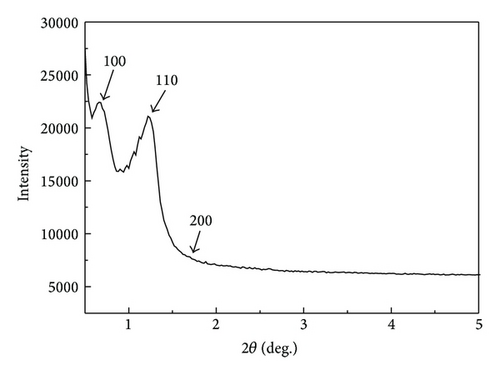
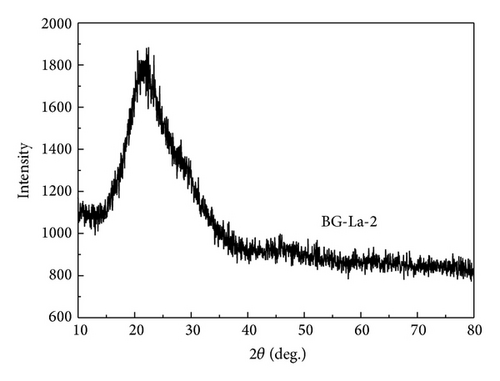
The TEM analysis was performed to investigate the microstructure and porous arrangement mode of the BG-La materials. Results are shown in Figures 2(a)–2(e). BG-La materials had uniform and regularly arrayed pores with average pore size. And as the red marks shown in Figures 2(a), 2(b), 2(c), and 2(e), samples 1–3 and 5 have ordered two-dimensional six-party channel structure, consistent with the XRD test results. The morphological structure of BG-La was characterized by SEM and shown in Figure 2(f). It could be observed that no obvious crystal was formed and the BG-La existed in amorphous state.
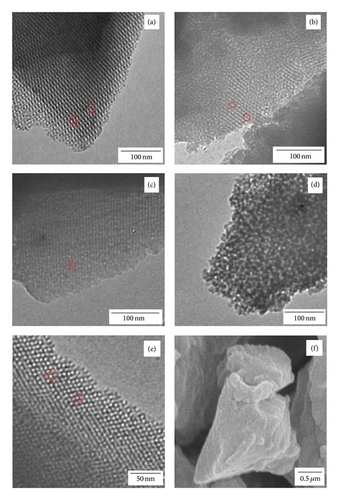
The N2 adsorption-desorption isotherm and the pore size distribution of BG-La-2 material are shown in Figure 3. The nitrogen adsorption-desorption isotherm can be identified as type IV isotherm characteristic of mesoporous structure. The mesoporous sample exhibits hysteresis loop at the P/P0 range of 0.4–0.8. The hysteresis loop is probably due to the existence of textural interparticle mesoporosity. The sample shows a pore size distribution centered between 2 and 3 nm. The detailed textural and porous parameters are listed in Table 2.
| Adsorbent | Surface area (m2g−1) |
Pore volume (ccg−1) |
Pore diameter (nm) |
|---|---|---|---|
| BG-La-1 | 293 | 0.41 | 2.6 |
| BG-La-2 | 289 | 0.30 | 2.4 |
| BG-La-3 | 303 | 0.45 | 3.1 |
| BG-La-4 | 316 | 0.49 | 3.7 |
| BG-La-5 | 311 | 0.47 | 3.5 |
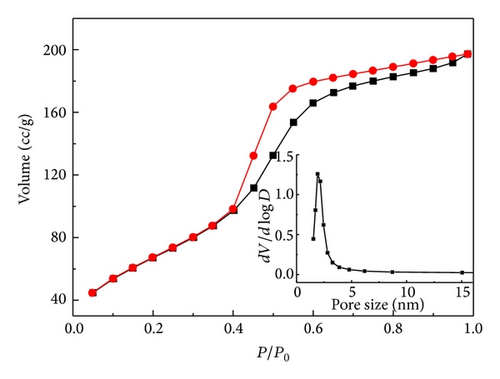
XPS spectrums of BG-La-2 are shown in Figure 4. Five remarkable intense peaks were displayed in Figure 4(a) showing the main elements in samples of BG-La-2. The peak at 854.8 eV correspond to La3d3/2 XPS spectrum (Figure 4(b)). And the two peaks at 841.2 eV and 836.4 eV both correspond to La3d5/2 (Figure 4(b)); this is bimodal phenomenon; the emergence and intensity of the bimodal phenomenon reflect the ability of lanthanum to get O2p electronic ability, namely, the size of the La-O covalent [16]. The above results suggest the presence of La2O3 in BG-La materials [17].
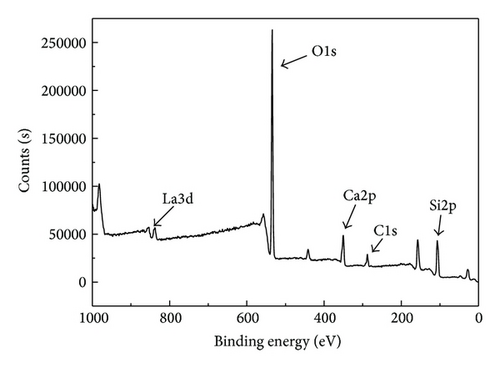

3.2. Effects of Operating Conditions on MB Adsorption
3.2.1. Effect of Contact Time
Under the same initial conditions BG-La-1~5, respectively, tested the adsorption equilibrium time and the results were shown in Figure 5. BG-La-1 and 2 reached adsorption equilibrium within 2 h as shown in Figure 5, and BG-La-3~5 reached adsorption equilibrium within 6 h. The removal rate R (%) of BG-La-1 and 2 had reached more than 95% within 5 min, and after reaching adsorption equilibrium the removal rate was close to 100%; this also reflected their good mesoporous structure.
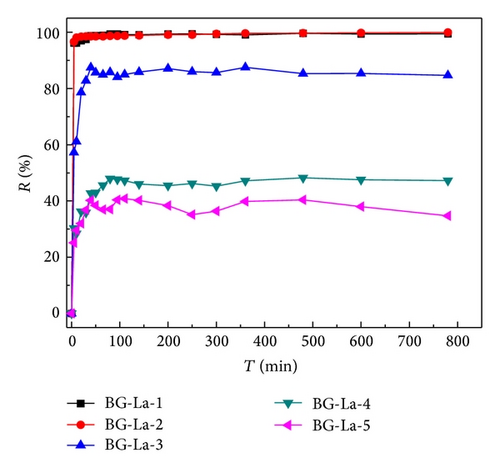
3.2.2. Effect of Initial Solution pH
The solution pH is another important factor in determining the adsorption properties of adsorbent. Figure 6 displays the variation in the amount of adsorbed MB by BG-La adsorbent with the initial solution pH ranging from 2 to 12. It is noted that adsorption of MB onto BG-La-2 is drastically influenced by initial pH and the removal rate increased with the increase of pH value. The maximum dye adsorption was observed at pH 10.0. Analyzed from the structure of adsorbent and contaminate molecule, it is known that the adsorption of these charged dye groups onto the adsorbent surface is primarily influenced by the surface charge which is in turn influenced by the solution pH [18].
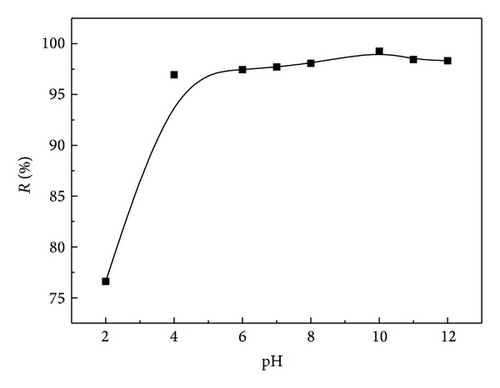
3.2.3. Effect of Initial MB Concentrations
Figure 7 shows the effects of initial MB concentrations (5, 10, 20, 30, 40, and 50 mg/L) on BG-La-1~5 and undoped mesoporous bioactive glasses (BG-1~5). It can be easily observed that the removal rates of BG-La-1~5 are higher than BG-1~5, and the removal rate decreased with the increase of initial MB concentrations. As shown in Figure 7(b), BG-La-2 keeps a high removal efficiency at different initial concentrations, and its removal rate is above 99%.
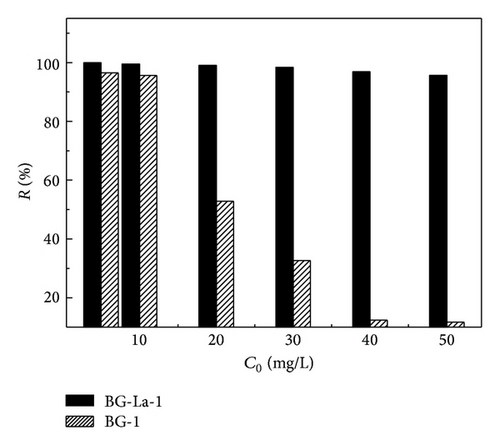
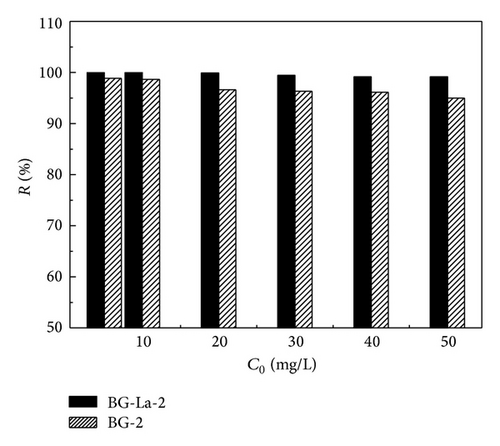
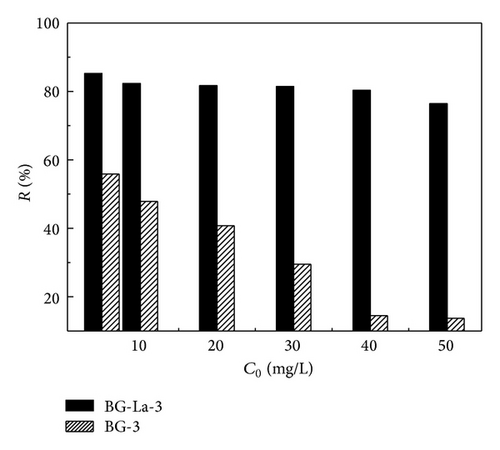
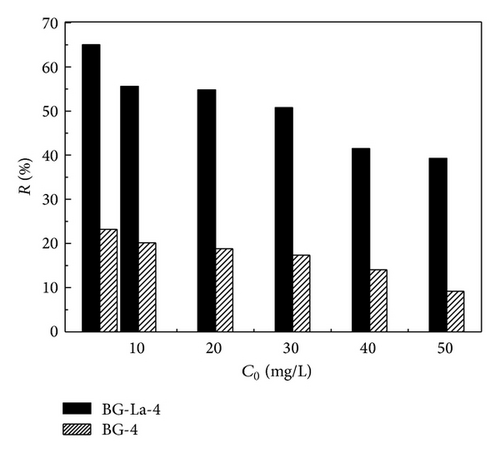
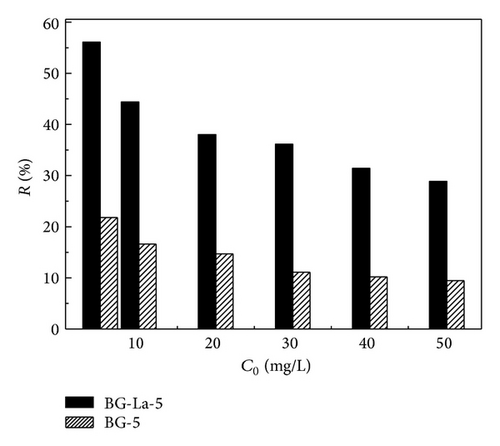
3.3. Adsorption Kinetics
In our earlier study, it is noticed that the adsorption capacities of BG-La have direct correlation with its surface area and pore structure. Thus, in this section, BG-La-2 which have the largest surface area and regular porous structure were tested as optimized adsorbents.
| Adsorbent | qe,exp | Pseudo-first-order kinetic model | Pseudo-second-order kinetic model | ||||
|---|---|---|---|---|---|---|---|
| q1e,cal (mg/g) | k1 (min−1) | R2 | q2e,cal (mg/g) | k2 (g/(mg min)) | R2 | ||
| BG-La-1 | 8.64 | 0.22 | 0.012 | 0.8636 | 8.62 | 0.337 | 1 |
| BG-La-2 | 8.66 | 0.14 | 0.003 | 0.9021 | 8.66 | 0.136 | 0.9999 |
| BG-La-3 | 7.59 | 1.55 | 0.014 | 0.8175 | 7.40 | 6.363 | 0.9998 |
| BG-La-4 | 4.18 | 1.37 | 0.018 | 0.9152 | 4.14 | 0.047 | 0.9995 |
| BG-La-5 | 3.54 | 0.94 | 0.015 | 0.9192 | 3.18 | −0.076 | 0.9934 |
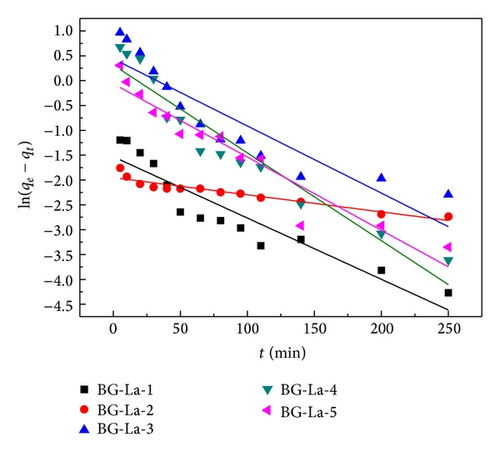
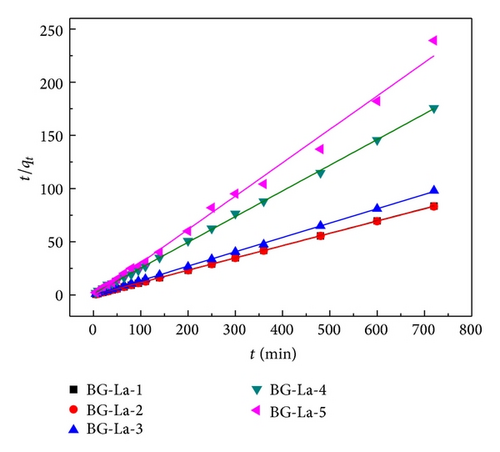
The kinetic data were analyzed by the aforementioned kinetic equations, and corresponding parameters were calculated in Table 3. The values of correlation coefficient (R2) obtained from pseudo-second-order kinetics were higher (>0.99) than those from pseudo-first-order kinetics and the values of q2e,cal were closer to experimentally obtained adsorption capacity (qe,exp), and thus pseudo-second-order kinetics could reasonably describe the adsorption process for the adsorption systems.
3.4. Adsorption Isotherms
Adsorption isotherm is important to describe how solutes interact with adsorbents, and it is critical in optimizing an adsorption process to indicate how the adsorbed molecules distribute themselves between liquid and solid phases until the adsorption process reaches an equilibrium state. The different isotherm models are used to analyze adsorption equilibrium data. An accurate mathematical depiction for adsorption process is indispensable for reliable prediction for adsorption process and quantitative comparison of adsorption behaviors. In the present study, the adsorption equilibrium data were analyzed by the Langmuir and Freundlich isotherm models.
The relative parameters based on Langmuir and Freundlich were calculated and listed in Table 4, and the Freundlich isotherms of MB on BG-La were shown in Figure 10. BG-La-3~5 do not conform to the Langmuir isotherm model. According to coefficient (R2), it is suggested that the adsorption of MB on the BG-La is better modeled by the Freundlich isotherm than the Langmuir isotherm. These results indicate that the MB molecules are not bonded as a monolayer on the surface of the BG-La adsorbent. The higher adsorption capacity of (Qm) of BG-La-2 may be attributed to the larger surface areas and mesoporous structure.
| Adsorbent | Langmuir isotherm | Freundlich isotherm | ||||
|---|---|---|---|---|---|---|
| Qm (mg/g) | KL (L/mg) | R2 | KF (mg/g) | 1/n | R2 | |
| BG-La-1 | 20.69 | 13.73 | 0.9795 | 19.02 | 0.41 | 0.9878 |
| BG-La-2 | 16.75 | 8.29 | 0.9887 | 42.85 | 0.46 | 0.9943 |
| BG-La-3 | ∖ | ∖ | ∖ | 1.68 | 1.45 | 0.9765 |
| BG-La-4 | ∖ | ∖ | ∖ | 0.09 | 2.06 | 0.9891 |
| BG-La-5 | ∖ | ∖ | ∖ | 0.03 | 2.27 | 0.9899 |
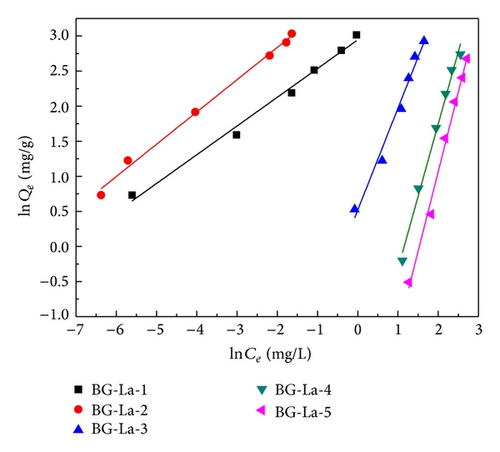
3.5. Thermodynamic Parameters
| T (K) | ΔG0 (kJ/mol) | ΔH0 (kJ/mol) | ΔS0 (J/mol K) |
|---|---|---|---|
| 303 | −5.3 | 73.9 | 261.5 |
| 313 | −7.9 | ||
| 323 | −10.6 |
The negative reflect of ΔG0 is spontaneous and feasible. In addition, the decrease in ΔG0 with an increase in temperature and ΔH0 > 0 indicates that the adsorption is better at higher temperature. Furthermore, ΔS0 > 0 suggest the increasing randomness at the solid-solution interface during fixation of MB onto the active sites of BG-La [19].
3.6. Photocatalytic Degradation of Methylene Blue in Water
Figure 11 depicts a plot of R (%) versus time for the degradation of MB over prepared BG-La-1~5 under UV light irradiation. It is noted that the degradation of MB onto BG-La-1~5 is drastically influenced by UV light irradiation and the removal rate increased with the increase of time. All the materials reached degradation equilibrium within 2 h and BG-La-2 still maintained a high removal rate (>99%). Furthermore, the removal rate of the degradation equilibrium of BG-La-4 and 5 significantly increased by about 10% compared to the removal rate of the adsorption equilibrium. This suggests that the lanthanum doped mesoporous bioglass has the ability of photocatalytic degradation.
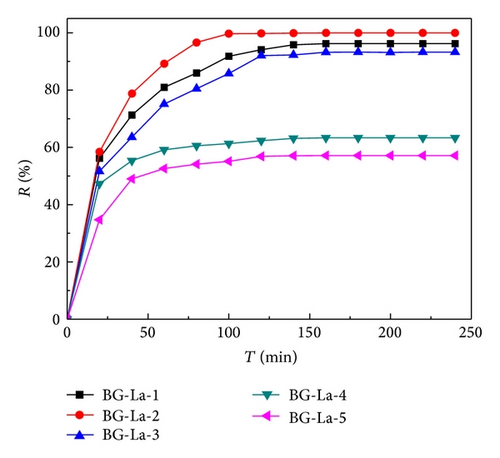
3.7. The Stability and Reusability of BG-La
The stability and reusability ability is significant for the practical application of adsorbents. Such adsorbents which have excellent adsorption capacity as well as high reusability will reduce secondary pollution and overall cost. Thus, the reuse experiments of BG-La were performed to evaluate the recyclable availability. The same mass of BG-La-1~5 was dissolved, respectively, in the same volume of MB solution (20 mg/L); after reaching adsorption saturation reuse experiment was carried out, the regeneration products were roasted at 500°C in 1 h. Figure 12 shows the TEM images of regeneration products. The microstructure and porous arrangement mode of regeneration products were the same as the original products mostly. The adsorption-regeneration experiments were repeated for 10 times and then the datas of reusability were gotten, as shown in Figure 13. It could be observed that the decline trend of removal rate of BG-La regeneration products became slowing down after 5 times of adsorption-regeneration experiments, and BG-La-1 and 2 still kept a high removal rate (>90%) after 10 times of adsorption-regeneration experiments. Therefore, the BG-La materials are expected to be employed repeatedly in dying wastewater treatment.
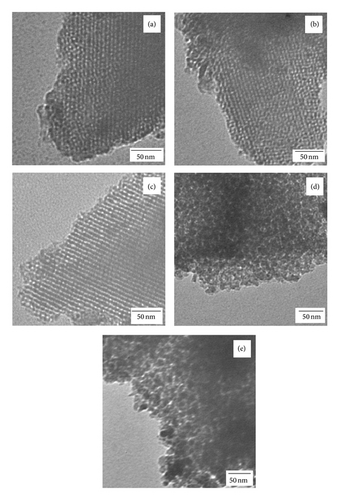
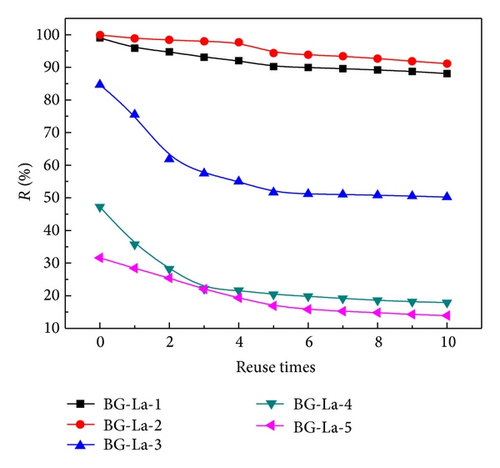
4. Conclusions
A facile synthesis method for BG-La was proposed in the present work; the average pore diameter is about 2.5 nm with the ordered two-dimensional six-party channel structure. In bath adsorption experiments, it was demonstrated that the adsorption was tremendously affected by pH, initial concentration, and temperature. The kinetics studies proved that the adsorption process agreed with the pseudo-second-order kinetics. The equilibrium study was well fitted by the Freundlich isotherm model. The thermodynamics parameters indicated that the adsorption is better at higher temperature. Furthermore, the BG-La showed excellent reusability ability and photocatalytic activity which made these materials possible in environmental application.
Conflict of Interests
The authors declare that there is no conflict of interests regarding the publication of this paper.
Acknowledgments
The authors are grateful to the financial support from the National Natural Science Foundation of China (no. 30901221) and Science and Technology Commission Foundation of Tianjin (no. 10JCZDJC17100 and no. 14JCZDJC38100).




